Starling Pigeon: Behavior and Breed Guide
Greetings, fellow feather fanatics! Prepare to enter a realm of avian allure – the scintillating sphere of the Starling Pigeon pigeon.
These birds are no plain pigeons; they’re kaleidoscopic works of natural artistry honed over centuries by discerning German fanciers.
Tracing their origins to the 1600s, Starling Pigeons have been sculpted into svelte avian acrobats, their iridescent elegance unrivaled in the pigeon realm. From aerobatic antics to finery that dazzles the keenest eye, these creatures are sure to captivate.
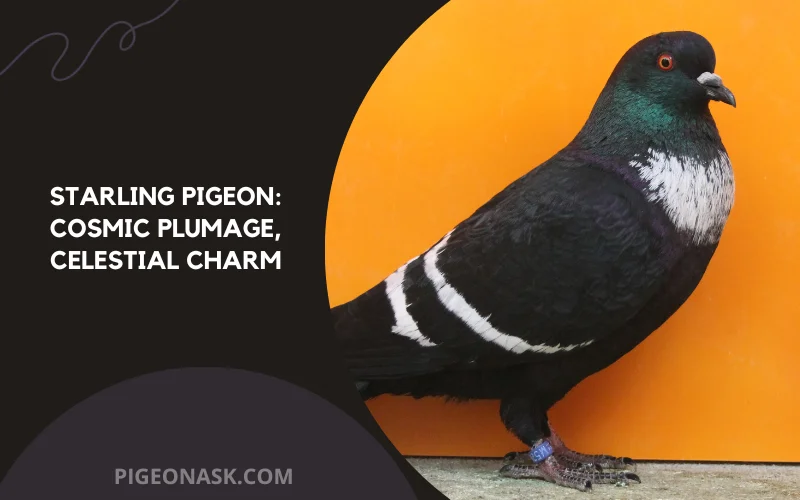
So join us as we unfurl the mystique of the meticulously molded and richly hued Starling Pigeon Pigeon!
Starling Pigeon Profile
| Attribute | Information |
|---|---|
| Name | Starling Pigeon Pigeon |
| Scientific Name | N/A |
| Common Names | Etourneau, Startaube, Stornello, and Скворец |
| Origin | Central and southern regions of Germany |
| Size | 11.8–14.2 in (30–36 cm) long |
| Weight | 9.3–13.4 oz (265–380 g) |
| Lifespan | Adults can live up to 15 years, but in feral populations, the lifespan is around four years |
| Physical Features | Slender body type, dark upper beak, light lower beak, bearded feature, yellow or broken eyes, thin narrow crest, and white or faded tail edge feathers. Various colors, including black, blue, yellow, and red. |
| Temperament | Lively nature |
| Behavior | Excellent flyer, suitable for raising as pets |
| Special Features | Iridescent feathers |
| Breeding and Maintenance | Bred for both flying and show purposes, suitable for keeping as pets due to its hardy and strong nature |
| Common or Popular Varieties | Smooth head or shell-peak crested, white-head variety, full colored head variety, dark head variety, and Monk marked variety |
Interested in similar topics on pigeon breed:
Overview Of Starling Pigeon
Starling Pigeon pigeon is a captivating breed that has undergone a transformation through meticulous selective breeding.
Tracing its roots to 17th century Germany, the Starling Pigeon has been meticulously molded into a living masterpiece through selective breeding. This slender bird rocks a dark upper beak, a light lower beak, and a classy goatee for good measure.
But it’s Starling Pigeon’s plumage that really steals the show. Iridescent feathers shine in captivating hues of black, blue, red and yellow.
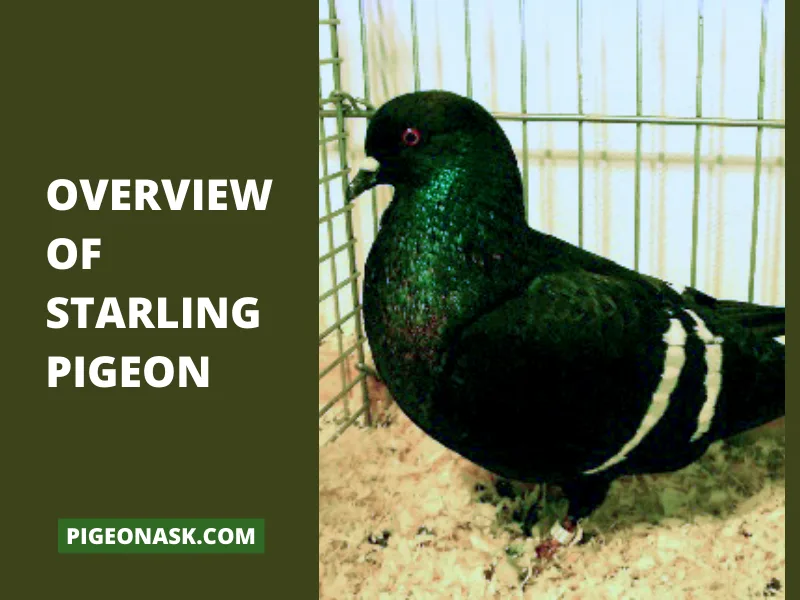
Those striking peepers come in shades of yellow or orange too. When they spread their wings, it’s a kaleidoscope of color!
Despite its ominous vibe, this animated aviator flaps about with pep. Watch Starling Pigeons take to the skies and you’ll see their lively nature in action. These robust birds make hearty pets as well.
So, whether you’re wowed by its looks or inspired by its vitality, the Starling Pigeon pigeon dazzles on every level.
Centuries of selective breeding have transformed this fancy flyer into a living canvas. Just gaze in wonder at this avicultural work of art!
We have covered an in-depth article on “Colour pigeons“; if interested, you can check this article here.
History And Origin Of Starling Pigeon
The Starling Pigeon is a fancy breed with roots tracing back to Germany, where it has been a cherished companion for centuries.
Believed to be a descendant of the rock pigeon, the ancestor of all domesticated pigeons, the Starling Pigeon pigeon has a rich history dating back to the 1600s, when it was enthusiastically bred in South Germany and Thuringia.
Physical Characteristics And Features
The physical world of the Starling Pigeon Pigeon, where every feather tells a unique story.
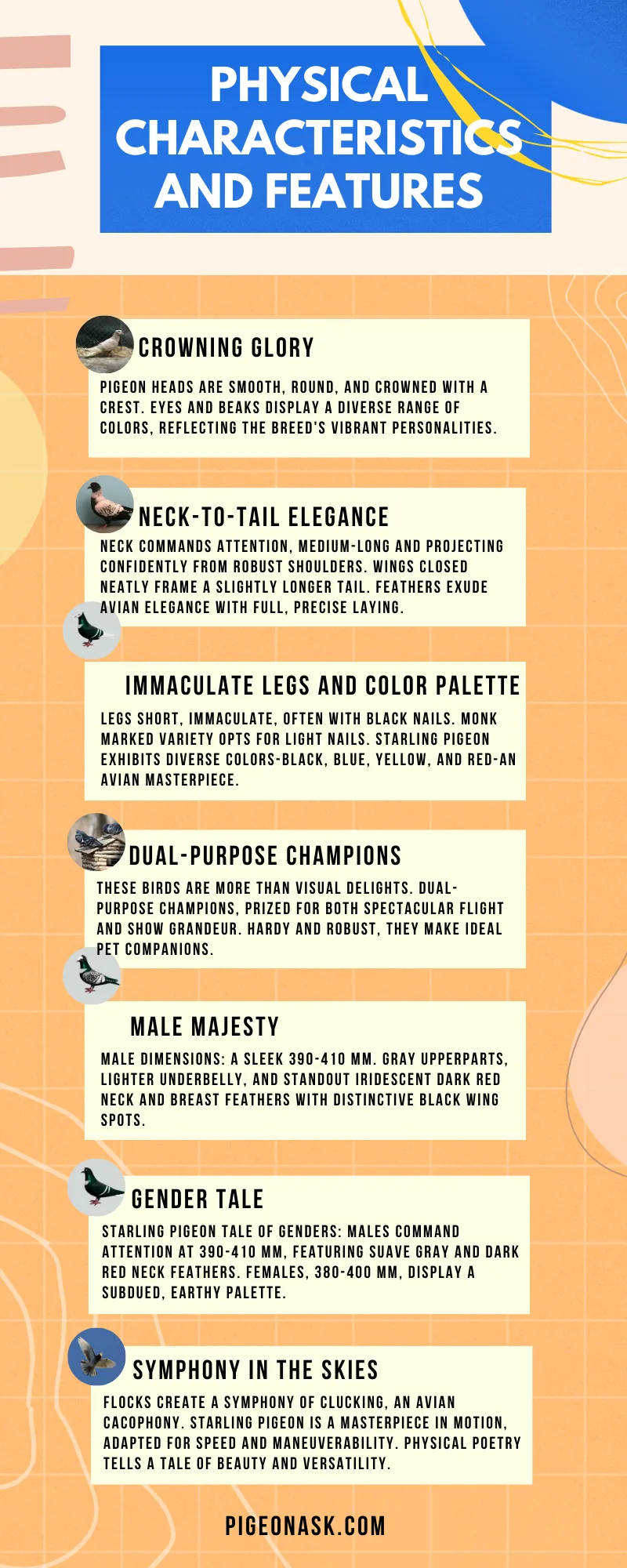
Picture an average-sized bird but with a robust stance that sets it apart. It’s got that classic pigeon look but with a slender twist – a more streamlined body type that catches the eye.
Crowning Glory
Now, let’s talk heads – smooth, longly round, lightly arched, and crowned with a crest.
Their eyes? A canvas of variety, with colors that depend on the pigeon’s unique flair. Beaks follow suit, showcasing a spectrum that matches the vibrant personalities within the breed.
Neck-to-tail Elegance
Moving down, the neck takes center stage – medium-long and confidently jutting forward from strong shoulders.
The wings? Neatly closed, framing a tail that’s just a tad longer than the flight tips. And oh, those feathers – full, thick, and laid down with precision, creating a picture of avian elegance.
Immaculate Legs and Color Palette
Legs, short and immaculate, usually adorned with black nails. However, the Monk marked variety likes to switch it up with light nails.
Now, onto the palette – the Starling Pigeon Pigeon comes in common colors like black, blue, yellow, and red, each shade a brushstroke in this avian masterpiece.
Dual-Purpose Champions
And here’s the beauty of it all – these birds aren’t just a feast for the eyes. They’re dual-purpose champions, raised for both the spectacle of flight and the grandeur of shows.
Plus, their hardy and robust nature makes them perfect companions as pets.
Male Majesty
Now, let’s zoom in on the male’s dimensions – a compact 390 to 410 mm of avian elegance.
Picture mainly gray upperparts, a lighter underbelly, and the pièce de résistance – iridescent dark red feathers on the neck and breast, accompanied by those distinctive black spots on the wings.
Gender Tale
In a gender tale, the Starling Pigeon Pigeon brings a sizeable difference. Males take the spotlight at 390-410 mm, while females grace the scene at 380-400 mm.
Plus, males showcase that suave gray adorned with dark red neck feathers, while females bring a more subdued, earthy palette into the mix. Long, pointed wings, a wedge-shaped tail, and a body built for aerial ballet complete the picture.
Symphony in the Skies
Their flocks? They’re the symphony of clucking noises, a cacophony of avian conversation.
Adapted for speed, endurance, and maneuverability, the Starling Pigeon Pigeon isn’t just a bird; it’s a masterpiece in motion.
And there you have it – the physical poetry of the Starling Pigeon Pigeon, where every detail tells a tale of beauty, versatility, and the artistry of nature.
At a glance –
| Physical Feature | Description |
|---|---|
| Size | Average-sized breed with a robust appearance. |
| Head | Smooth, longly round, lightly arched, and crested. |
| Bill | Color of the beak can vary depending on the variety. |
| Eyes | Color of the eyes can vary depending on the variety. |
| Neck | Medium-long, carried forward from strong shoulders. |
| Wings Tail | Wings are nicely closed, and the tail is closed, just a trifle longer than flight tips. |
| Feathers | Full and tick feathers, laying smoothly. |
| Legs | Short, fully clean, and usually with black nails, except the Monk marked variety with light nails. |
| Colors | Common colors include black, blue, yellow, and red. |
| Male Dimensions | Males measure 390-410 mm, mainly gray on upperparts, lighter on underparts, with iridescent dark red feathers on neck and breast, and black spots on wings. |
| Female Dimensions | Females measure 380-400 mm, with a duller and browner coloration. |
| Behavior | Lively and spirited nature. |
| Purposes | Raised for both flying and show purposes. Also suitable for keeping as pets due to hardy and strong nature. |
Different Strains And Unique Features
01. Black White Barred Starling Pigeon
Let’s zoom into the captivating world of the Black White Barred Starling Pigeon, a variety that wears its history with pride.
Originating from the ancient breeding grounds of South Germany and Thuringia since the 1600s, this bird carries the legacy of a bygone era.
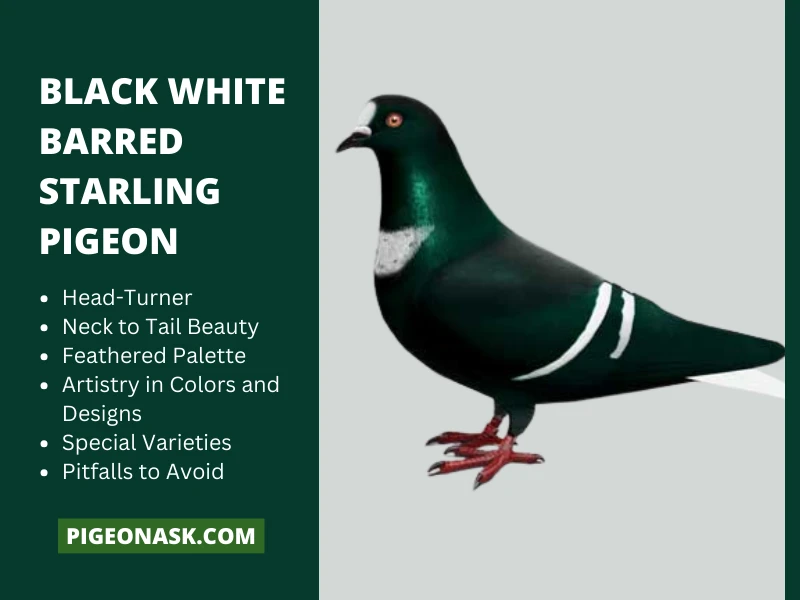
Picture Thuringian fanciers favoring the smooth head Starling Pigeon, particularly in the popular blue hue, while down south in Schwaben, it’s all about the blacks, especially in peak and shell crests.
Now, the General Impression? Think of the Starling Pigeon as a refined cousin of the common field pigeon – slender yet robust, a harmonious blend of strength and elegance.
Let’s break it down –
Head-Turner
Longly round, lightly arched, and crowned with either a smooth head or a striking shell-peak crest.
The eyes? A tale of contrast – dark in the white-head varieties, fiery red in full-colored heads.
And oh, the beak! Dark, except for the Monk marked variety, which flaunts a flesh-colored upper beak.
Neck to Tail Beauty
Medium-long neck confidently carried forward from strong shoulders. A back that widens at the shoulders and tapers downward, creating a sleek profile.
The wings? Neatly closed, framing a tail that’s just a trifle longer than the flight tips. Legs? Short, fully clean, and usually boasting black nails.
Feathered Palette
The plumage is a canvas of colors – black, blue, red, and yellow, each telling a story. But it’s not just about the hues; it’s about the intricate designs.
Artistry in Colors and Designs
Picture this: Blacks with a deep black ground color, a green sheen, and a half-moon on the breast, showcasing a grey to pure white design.
Blues rocking a pure, clean blue ground color with the same moon design as blacks.
Reds and Yellows, each with their distinctive moon and bars, mirroring the elegance of the black variety.
Special Varieties
- White-Heads (Blasse) – Robust appearance, white shell crest, and a distinctive black fleck between the beak corners and eyes.
- White-Tails – Sharing the design of blacks but with 12 white tail feathers stealing the spotlight.
- Monked – Sporting the usual monk design, a pointed crest, and that signature white head design.
Pitfalls to Avoid
In this world of avian artistry, faults can be deal-breakers. Faded feathers, off-colored heads, or uneven lacing – these are the red flags.
In blues, beware of grizzling, light flights, or broken bars. Marmostars need that pearl design, and Silverlaced should steer clear of uneven colors and grizzling.
02. Blue White Barred Starling Pigeon
Black White Blue White Barred Starling Pigeon, a variety steeped in history and grace. Have a look at it’s best features –
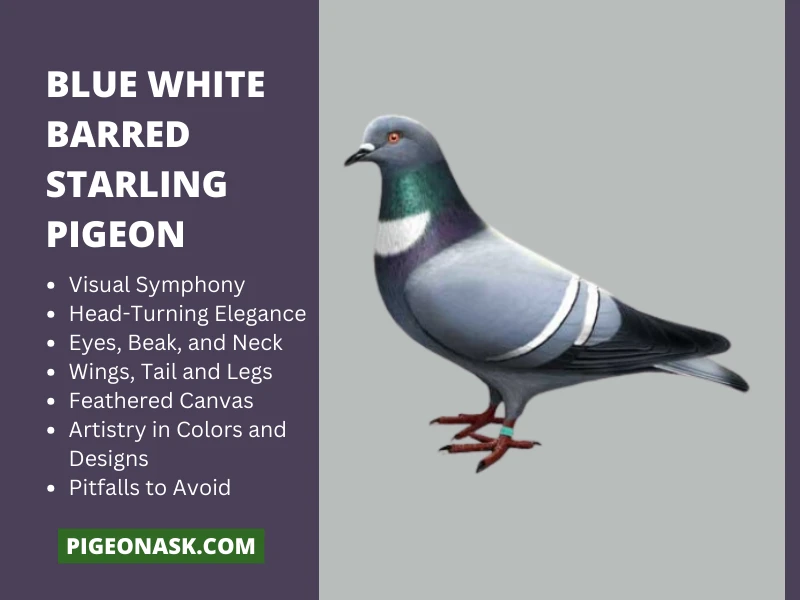
Visual Symphony
Imagine a bird that echoes the familiar silhouette of a common field pigeon but elevates it to a whole new level – slender yet exuding strength in its form.
Head-Turning Elegance
The head, longly round and lightly arched, sets the stage for the unique charm of this Starling Pigeon. It can either sport a smooth head or captivate with a shell-peak crest, adding an extra layer of allure.
Eyes, Beak, and Neck
Eyes play a pivotal role – dark in white-head varieties and fiery red in full-colored heads. The beak is a dark masterpiece, except for the monk-marked, where it takes on a flesh-colored hue.
And the neck, medium-long and full, gracefully carried forward from strong shoulders.
Wings, Tail and Legs
The wings neatly closed, the tail closed and just a trifle longer than flight tips – a symphony of avian aerodynamics. Legs, short and fully clean, adorned with black nails, unless it’s the monk-marked variety, which flaunts light nails.
Feathered Canvas
Picture a canvas painted in rich hues – black, blue, red, and yellow. The blacks can showcase white heads, white tails, or monk-marked elegance. And then there’s the intricate play of white lacing, a delicate dance on feathers.
Artistry in Colors and Designs
- Blacks – Deep black with a green sheen, a half-moon on the breast in shades of grey to pure white, and pure white bars.
- Blues – Pure blue, clean and light, mirroring the moon design of blacks with pure white bars edged in black.
- Red & Yellow – Ground color in vibrant red or yellow, echoing the moon and bars of the black variety.
Pitfalls to Avoid
Every masterpiece has its standards. Feathers on legs or toes? A no-go. Faded colors, off-colored heads, or broken tail edges – all red flags in this avian gallery.
03. Marmorstar or Laced Starling Pigeon
As you immerse yourself in the world of Marmorstar or Laced Starling Pigeons, remember that each bird is a living masterpiece, a result of centuries of passion, expertise, and an unwavering commitment to avian elegance.
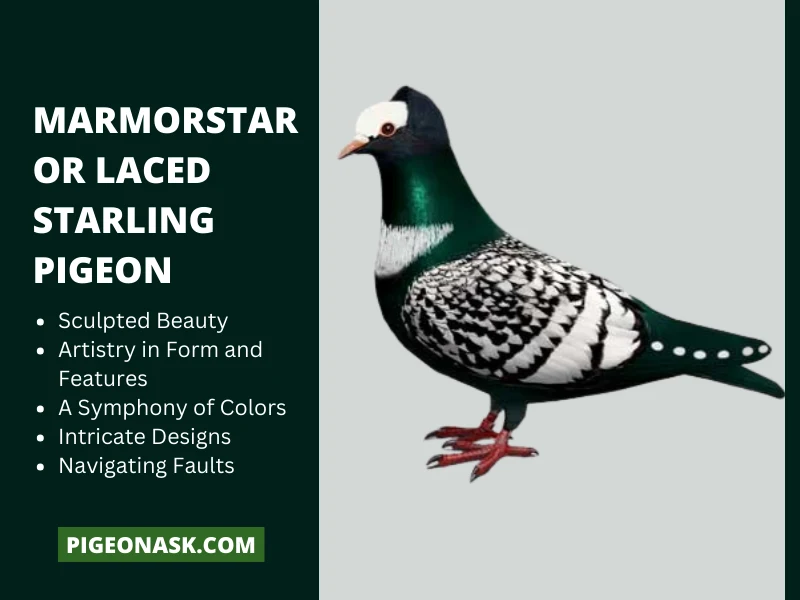
Sculpted Beauty
Imagine a bird that mirrors the common field pigeon but stands out with a slender yet robust form. The general impression is a testament to centuries of selective breeding, resulting in a creature that exudes strength in every feather.
Artistry in Form and Features
The head, longly round and lightly arched, can boast a smooth elegance or the captivating allure of a shell-peak crest.
Eyes, the windows to avian souls, vary from dark in white-head varieties to fire red in full-colored heads.
The beak is a dark masterpiece, except for the flesh-colored wonder in monk-marked variations.
A Symphony of Colors
The palette of Marmorstar or Laced Starling Pigeons is a visual symphony. Blacks, blues, reds, and yellows dance on their feathers, each hue telling a unique story.
Whether it’s the elegant white-heads or the distinctive white-tails, these birds are a canvas of nature’s finest hues.
Intricate Designs
The meticulous designs on these birds elevate them to avian artistry. Imagine blacks with a deep black ground, a crescent moon on the breast, and pure white bars.
Blues echoing the same elegance with pure blue grounds and delicate black edging on pure white bars. Each variety, from Monk to silverlaced, bears its signature design, a testament to the artistry of nature.
Navigating Faults
Perfection has its standards, and Marmorstar or Laced Starling Pigeons are no exception.
Faults range from feathers on legs or toes to off-colored heads, a meticulous evaluation that ensures the breeding of the finest avian specimens.
04. Black White Barred Monk Marked Starling Pigeon
Picture a bird that echoes the common field pigeon but emerges more slender yet distinctly robust in form.
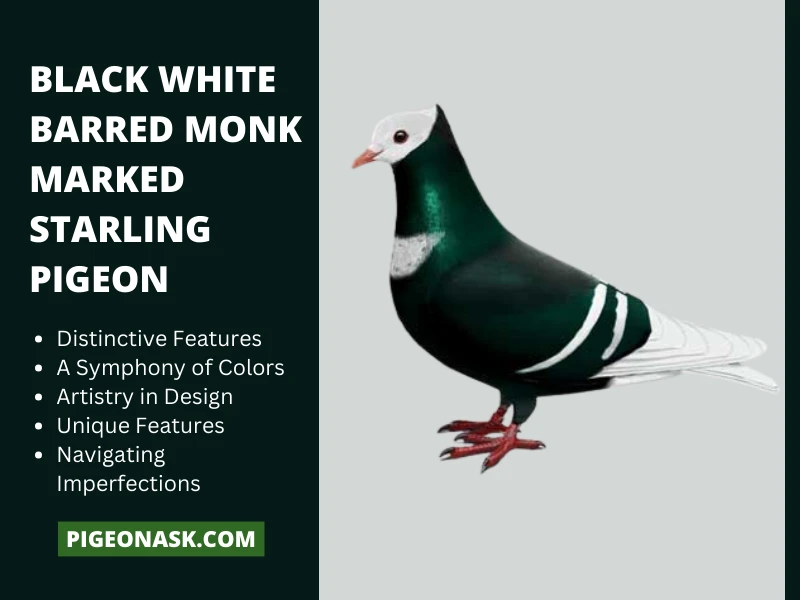
The general impression is a harmonious synthesis of elegance and strength, a hallmark achieved through selective breeding and a keen eye for avian aesthetics.
Distinctive Features
- Head: Longly round, lightly arched, presenting a canvas for either a smooth head or a captivating shell-peak crest.
- Eyes: Varied hues, from the dark intensity in white-head varieties to the fiery red in fully colored heads, create a mesmerizing gaze.
- Beak: A masterpiece in darkness, with exceptions in monk-marked variations where the flesh-colored beak becomes a unique feature.
- Neck and Back: Medium-long neck, full and gracefully carried forward from the shoulders. The back, wide at the shoulders, gently tapering downward.
- Wings and Tail: Closed wings and a tail just slightly longer than the flight tips contribute to the aerodynamic allure.
- Legs and Feathering: Short, fully clean-legged with striking black nails, or in monk-marked variations, dainty light nails. The feathers, full, thick, and lay smoothly, epitomize avian elegance.
A Symphony of Colors
The color palette of Black White Barred Monk Marked Starling Pigeons is a visual feast. From the deep blacks with a green sheen to the pure blues as clean and light as possible, each hue tells a story of selective breeding and aesthetic refinement.
Artistry in Design
The intricate designs on these pigeons elevate them to avian artistry. From the pure white bars on deep black grounds to the delicate edging on pure blue bars, each detail is a testament to the dedication of pigeon fanciers.
Unique Features
Monk Marking – The head’s pointed crest, setting high, initiates a white design curving under the eye, distinguishing the Monk Marked variation.
Navigating Imperfections
As with any masterpiece, faults are meticulously evaluated, from faded colors to broken tail feathers, ensuring that each Black White Barred Monk Marked Starling Pigeon is a paragon of avian excellence.
Distribution And Habitat
Starling Pigeon pigeons have established their presence across various landscapes in Europe and Asia. Their habitat preferences and adaptability to various environments can better be understood from the points below.
Geographic Distribution
The Starling Pigeon pigeons have a widespread distribution across several regions of Europe and Asia. Their distribution spans countries such as Germany, Poland, Turkey, Iran, India, and Pakistan.
Plus, their popularity among pigeon enthusiasts due to their striking appearance and unique aerial displays has led to their presence in many countries.
Habitat Preferences
Starling Pigeon pigeons prefer open environments with ample amount of space for them to flaunt their talent. They’re often seen in places with an open field or an open sky with no obstructions whatsoever.
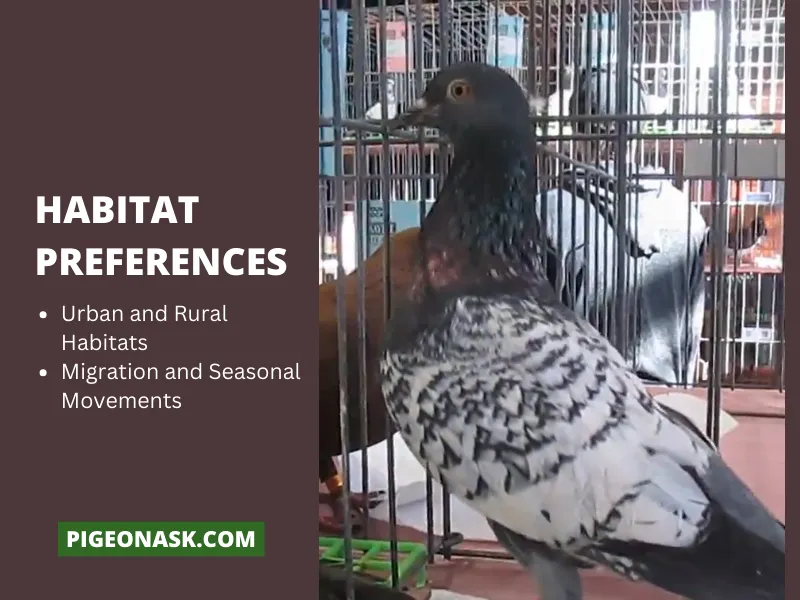
Urban and Rural Habitats: Starling Pigeon pigeons have adapted well to both urban and rural environments. In urban areas, they can be seen in city parks, open spaces, and rooftops.
And in rural regions, they are found in agricultural landscapes and open countryside. Their ability to thrive in diverse habitats contributes to their popularity among pigeon enthusiasts.
Migration and Seasonal Movements : The birds display a curious lack of loyalty to nesting sites, often picking new locations yearly. Nest colonies form months after their arrival, usually between late March to May.
Courtship happens in the colony, a unique twist where males flaunt their courtship moves on branches rather than the typical pigeon ground displays.
It’s an elaborate performance involving wing flourishes, distinct calls, and intricate rituals of bonding.
Seasonal movements might occur based on food availability and breeding conditions. However, these movements are usually localized and not extensive.
Threats and Conservation Status
Starling Pigeon pigeons are not yet considered threatened as a species. However, like many bird species, they face threats related to habitat loss due to urban development and agricultural intensification.
Ensuring the availability of suitable open spaces and preserving their habitats is crucial for their continued well-being.
Behavior And Traits
Let me introduce you to the captivating behavioral traits of the Starling Pigeon pigeon – a breed renowned for its grace, beauty, and aerial talents.
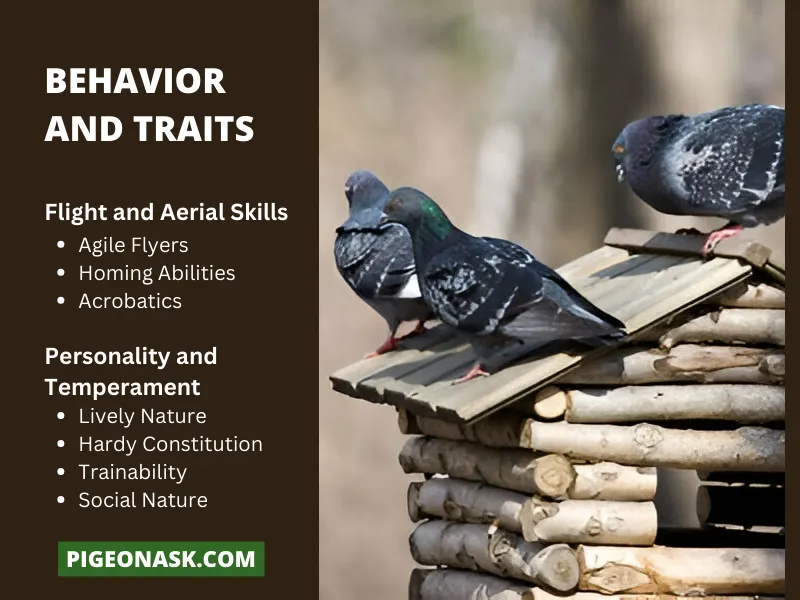
More than just a pretty face, Starling Pigeons impress with their vivid personalities and hardy natures. Read on to learn more about these fabulous, feathered companions!
Flight and Aerial Skills
Agile Flyers
Starling Pigeon pigeons are known for their speed and maneuverability in flight. Their slender, streamlined bodies and strong wing muscles allow them to fly swiftly and adeptly change directions mid-air.
Homing Abilities
Starling Pigeons have excellent navigation skills and can find their way back home over long distances. It’s believed they may orient themselves using the earth’s magnetic fields. This homing ability has made them popular as racing pigeons.
Acrobatics
Starling Pigeon pigeons sometimes display aerial acrobatics like backward rolls, somersaults, and tumbles. It is uncertain if this is an inherited trait or a learned behavior. Their aerial maneuvers demonstrate aerodynamic control.
Personality and Temperament
Lively Nature
Starling Pigeons are active birds that seem to have an innate curiosity and desire to explore their surroundings. Their lively nature is evident in their strutting walks and alert observation of their environment.
Hardy Constitution
Selective breeding has made Starling Pigeons robust, healthy birds resistant to many pigeon diseases. Their hardy biology enables them to thrive with basic care.
Trainability
Starling Pigeons are intelligent and can be trained to return to a home loft and become comfortable with handling when worked with gently over time. Their relatively calm disposition facilitates training.
Social Nature
Starling Pigeons appreciate company and interaction. Regular gentle handling when young accustoms them to human companionship. If isolated, they may become distressed.
Breeding And Maintenance
Here’s a lighthearted take on the breeding and maintenance of Starling Pigeon pigeons –
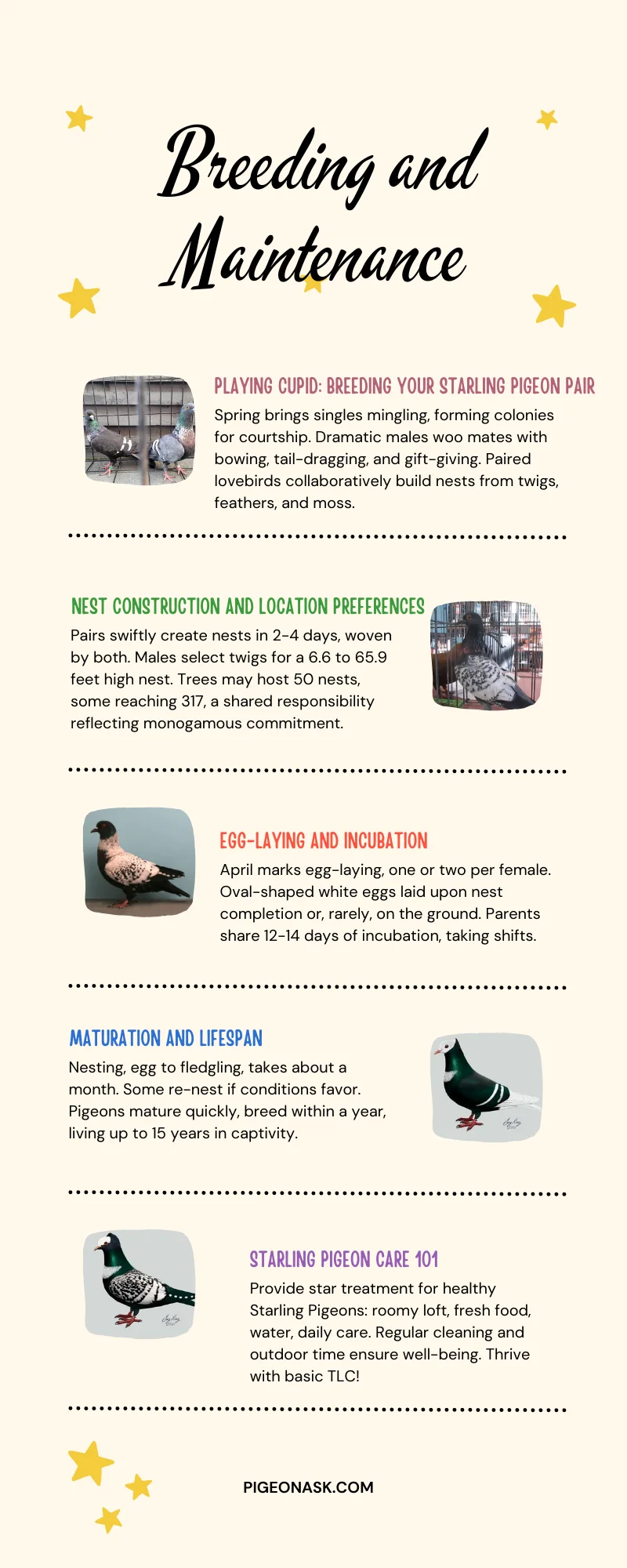
Playing Cupid: Breeding Your Starling Pigeon Pair
When spring rolls around, those singles are ready to mingle form colonies to get their court on! Dramatic males woo potential mates with bowing, tail-dragging, and gift-giving.
Once paired up, the lovebirds build a nest together from twigs, feathers, and moss.
Nest Construction and Location Preferences
Once pairs form, nests spring up within 2-4 days, meticulously woven by both partners. Twigs are meticulously selected and handed over by the male to construct a loose, shallow bowl-like nest, typically 6.6 to 65.9 feet above the ground.
Each tree could harbor over 50 nests, some even reaching a staggering 317. Nests are a shared responsibility, reflecting the monogamous commitment during nesting.
Egg-Laying and Incubation
Egg-laying commences around early April, usually one or two eggs per female, sometimes more if multiple females contribute to a single nest.
Eggs, oval-shaped and white, are laid immediately upon nest completion or, in rare cases, on the ground if nests are unfinished. Both parents share the 12-14 days of incubation, taking shifts during the day.
Eggstravaganza!
In March or April, the female lays 1-2 delicate white eggs. Both mom and dad take turns sitting on the eggs for about two weeks. Then voila – adorable squeaking and bobbling babies hatch!
From Fledgling to Flyer
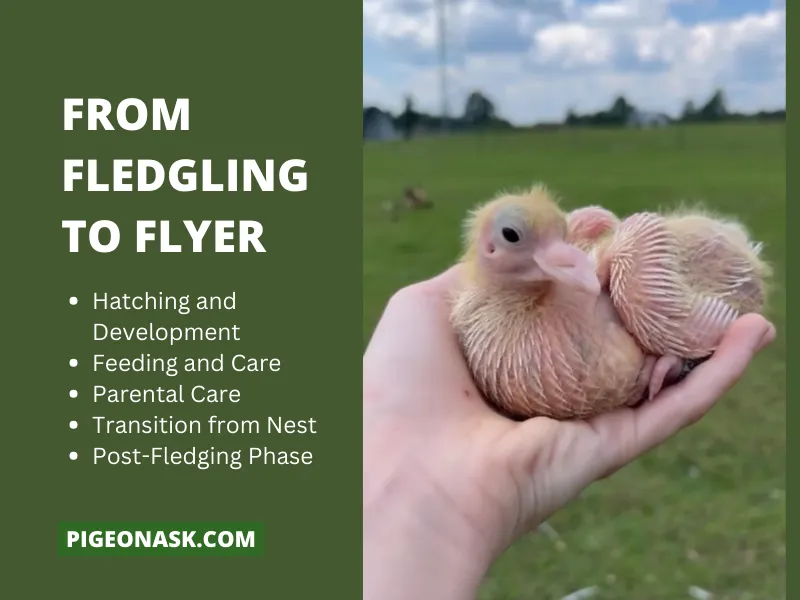
Hatching and Development
Upon hatching, the chicks, also called nestlings or squabs, are blind and covered with sparse, yellow hairlike down.
Rapid Development – Within approximately 14 days, the nestlings reach a weight similar to that of their parents.
Feeding and Care
Crop Milk Diet – Initially, the parents feed the chicks exclusively with crop milk, a substance akin to curd produced in their crops.
Introduction of Adult Food – After three to six days, the parents gradually introduce adult food to the chicks.
Parental Care
Shared Responsibility – Both male and female parents take care of the nestlings.
Feeding Schedule – The male attends to the nestlings during midday, while the female takes care of them at other times.
Transition from Nest
Last Feed and Departure – After 13 to 15 days, the parents feed the nestlings for the final time before abandoning them.
Fledging – Nestlings typically spend a day or two begging in the nest before moving to the ground. It takes them about three or four days to fully fledge.
Post-Fledging Phase
Seeking Food and Independence – After reaching the ground, the chicks move around, avoiding obstacles, and beg for food from nearby adults.
Full Independence – It usually takes three or four days from the ground for the chicks to fully fledge and become independent.
The developmental stages of the chicks involve attentive care and feeding from both parents until they gain Independence, displaying a gradual transition from the nest to becoming fully-fledged individuals.
Maturation and Lifespan
This entire nesting journey, from egg to fledgling, spans about a month, and some colonies even re-nest if conditions are favorable. These pigeons mature quickly, reaching sexual maturity within a year and breeding the following spring.
While they can live up to 15 years in captivity, the wild likely offers a shorter lifespan.
Starling Pigeon Care 101
Giving your Starling Pigeons the star treatment ensures healthy and happy birds! Provide a roomy loft with fresh food, water, perches, nest boxes, and grit daily.
Regular cleaning keeps things hygienic. Also, give them outdoor time to stretch their wings in a safe enclosure. With basic TLC, Starling Pigeons will thrive under your care!
So, there’s a peek into the breeding habits and care essentials for Starling Pigeon pigeons!
Let me know if you need any tips on preparing your birds for nesting season or keeping them healthy.
I’m always happy to share advice on ensuring your Starling Pigeons live their best lives!
Final Words
And there you have it – a glimpse into the captivating lives of the Starling Pigeon pigeon!
We hope you’ve enjoyed this foray into their life. These birds are truly testaments to the wonders of selective breeding and the splendor of nature’s palette.
Their unique flair and centuries of cultivation endow Starling Pigeons with an allure all their own.
For a more interesting take on pigeons like this, you can always find us on Twitter, Facebook and Google News. Happy browsing!
